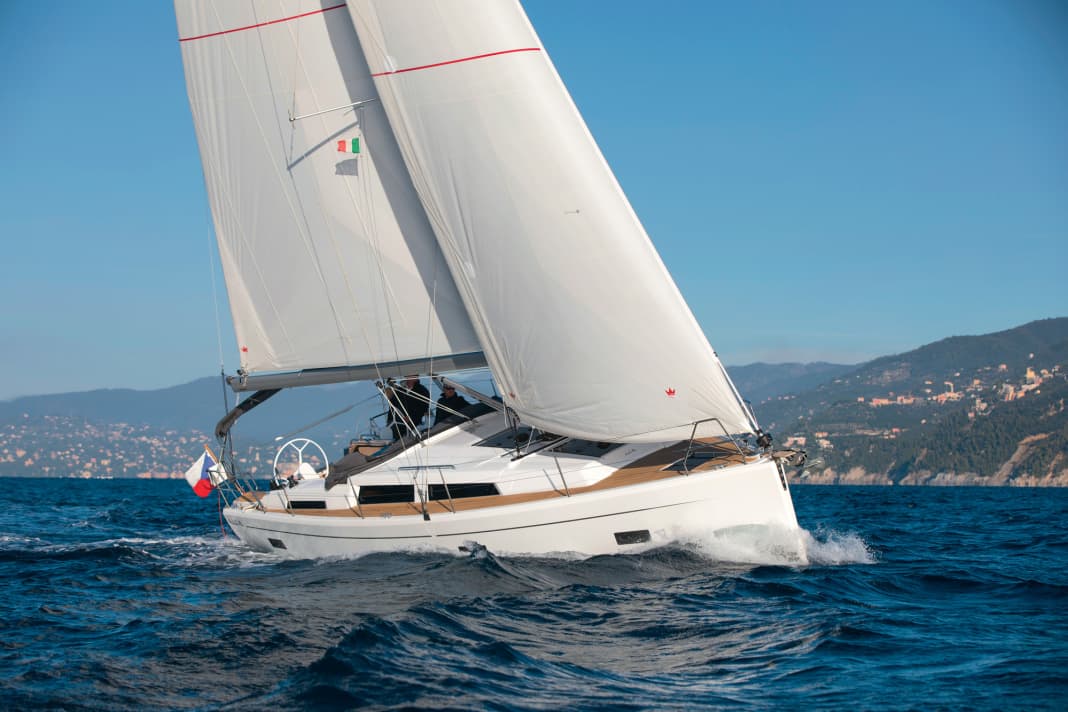





Evo instead of revolution, continuity instead of change: at the time, Hanseyachts favoured careful further development instead of new things for the sake of new things. This also applies to the Hanse 388, one of the most important boats in the cruising programme of the Greifswald-based group. YACHT tested the new 2019 volume model.
The size of just under twelve metres means a strong market across all shipyards in the boatbuilding industry, that of charter companies and that of owners. Hanseyachts traditionally finds private customers first and foremost. But the competition is fierce, as they also achieve large quantities in the charter scene through multiple sales, which in turn brings purchasing advantages and a strong market presence.
Completely new developments are expensive: conception, design, engineering, mould construction and marketing all cost money. A redesign saves a large proportion of these costs. The path taken by Hanse: take the tried and tested hull and rework the rest where it makes sense and where it can be improved.
The competition of the Hanse 388:
The Hanse 388 brings many small improvements
The Judel/Vrolijk design from 2011 is still up to date, and even the more recent competition offers no significantly visible or noticeable further developments. With its large volume, the Hanse was once a pioneer, but the maximum usable enclosed space is now the class standard.
Improving can mean incorporating experience from the market and from retailers, responding to new trends and implementing fresh or existing ideas or even saving hours. Hanse has implemented many smaller measures.
The sail area has increased slightly compared to the wardrobe of the predecessor Hanse 385, the standard keel is a few centimetres lower, the deck has been given more window areas, the stern and bathing platform have been improved and the interior has been completely redesigned, especially in terms of appearance.
The Hanse 388 stands for fast but easy cruising
The shipyard has stuck to the basic idea of fast but simple cruising sailing. The modern hull with a width of almost four metres and a massive bulkhead, a deep L-keel as standard and a free-standing rudder fin all stand for this. The mainsheet guide in front of the companionway and the self-tacking jib, which has been typical of the shipyard since the Hanse 291 prototype in 1992, as well as the line management system, speak in favour of good operating comfort. All halyards, sheets and outhauls are guided in the deck and through the cockpit coamings via spinlock lever clamps to two Lewmar winches mounted aft within the helmsman's radius of action. The helmsman always has the mainsheet running on both sides within reach, regardless of whether he is steering from windward or leeward.
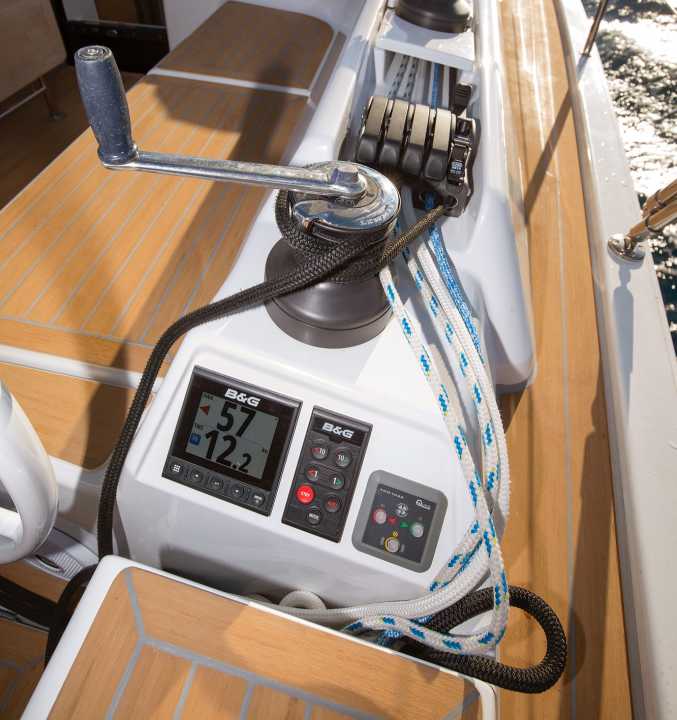
The system has advantages: It is extremely suitable for one-handed use and small crews, and it keeps the superstructure clear. The disadvantages: A lot of line material collects aft. Hanse counters this with two well-dimensioned stowage boxes. Nevertheless, it is necessary to tidy up to prevent unsightly wobbles. Minor drawback: The 40 mm winches offered as standard work at the lower limit, 45 mm would be more appropriate.
Steering the Hanse 388 is a pleasure
As is common today down to 31 feet, the boat is steered with two wheels. This makes it possible to steer far out to the side on the flat coaming with a good view forwards of the foresail, wind lines and waves and keeps the passage in the cockpit clear compared to a larger central single wheel.
On the Hanse 388, two wheels with a diameter of 90 centimetres transmit the steering commands to the quadrant of the single rudder via a chain-wire connection. As standard, these wheels are made of stainless steel, a variant that is rarely seen in real life on modern boats. GRP wheels, which are easier to handle thanks to their oval cross-section and resonate less due to their low weight, are a popular extra.
The Hanse 388 steers quite directly with just one turn from stop to stop. And that is fun. The boat can be wilfully guided to the wind edge. The speeds are very decent, up to 7 knots at the cross with a typical tacking angle of 90 degrees can be achieved at 11 to 12 knots. Below 10 knots, the small self-tacking jib, which is partly responsible for a rather tight sail load factor of 4.2, is likely to cut short the sailing fun, also because it opens too much at the top on courses with shrouded sheets and further reduces efficiency. In return, Hanse used to offer the genoa option with longitudinal rails, an offer that only a few customers took up.
Simple sails, good ergonomics
Hanse now relies on a so-called crossover, nothing other than a code zero, for use in less and more spacious wind conditions. If the boat comes as standard with white and horizontal plain fabric, the optional crossover is sewn together from higher quality cloth and increases the total bill by 5343 euros with Furler. This inevitably adds up to 821 euros for another anchor gallows, which takes up the neck of the sail, as well as halyard, two sheets and padeyes for a total of 940 euros. Two additional winches further forward on the cockpit coaming for 2321 euros are useful, but not essential.
In stronger winds, the sail area is reduced manually with Seldén's excellent single-line reefing system. The rig, equipped with two pairs of long spreaders, is also available in a furling version for an extra 2440 euros.
What is pleasing in the cockpit are the ergonomic dimensions. The space behind the wheels, which is cramped on many, especially smaller boats due to the backstay cockpit, is generous on the 388. If the helmsman is sitting sideways, he can put the wheel between his legs and support himself well, or he can retrofit footrests. The crew is supported by the fixed folding cockpit table (for which a refrigerator is also available) with footrest. The benches are sufficiently long at 1.60 metres, the coamings are high enough and comfortably shaped.
Lots of windows, lots of light
The shipyard's favoured arrangement of the lines leading to the helmsman enables a fog-free cabin roof. The companionway area was designed in a completely unusual way. In addition to the sliding hatch, dark tinted glass panes also cover the partially cut-out roof and the companionway bulkhead. The cabins can be ventilated with optional small deck hatches (1416 euros), and the glass provides significantly more light below deck. Additional window areas on two of the three deck hatches also contribute to this.
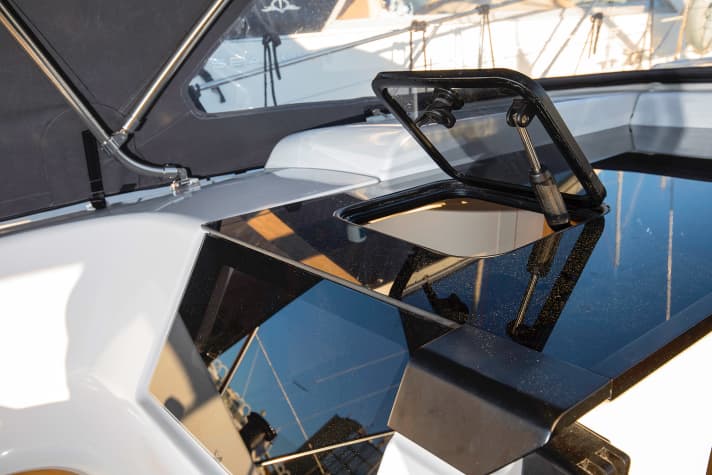
Also nice: there are two hatches in the foredeck, one in the standing area and one above the berth. Six large hull and six superstructure windows complete the natural light. In contrast, there is little cross-ventilation in the saloon. Although there is a centre hatch and the galley is located on the companionway, there is only one small window in the superstructure that can be opened. And this is only part of the cruising package.
Economic area instead of chamber
As a pioneer of customisation in large-scale production, Hanseyachts continues to offer a wide range of options. For the deck and cockpit alone, there are seven variants ranging from teak to synthetic teak with different wood looks and a variety of joints. The range continues with different colours for the hull, waterline, sprayhood, lazy bag and upholstery, options for the engine and keel, right through to the interior surfaces. Here, classic dark red mahogany is standard, grey Canadian walnut is a fairly new variant and French light oak (test boat) is popular. There is also a mix of familiar and contemporary designs for the flooring, with a classic striped look and three different light-coloured grains. New are wall unit fronts in a choice of two shades of grey. There is also the worktop in the pantry (black or white stone look) and a total of 21 different upholstery covers, including leather.
And last but not least, the interior layout remains variable. Two cabins and a walk-in locker to starboard, which could also be used and labelled as a utility room, are standard. A second bathroom is possible in the foredeck, but this halves the access to the berth. The customer can order a second aft cabin instead of the large forecastle. In this case, the standard gigantic galley shrinks to normal dimensions. In the saloon, there is still the option of two additional berths: the navigation table, which is now well-sized again, can then be lowered and covered with a cushion to extend the berth. The saloon table can be lowered opposite - an arrangement for 2368 euros that creates two to three emergency berths and can thus replace the second aft cabin - or increases the number of berths to a whopping eight.
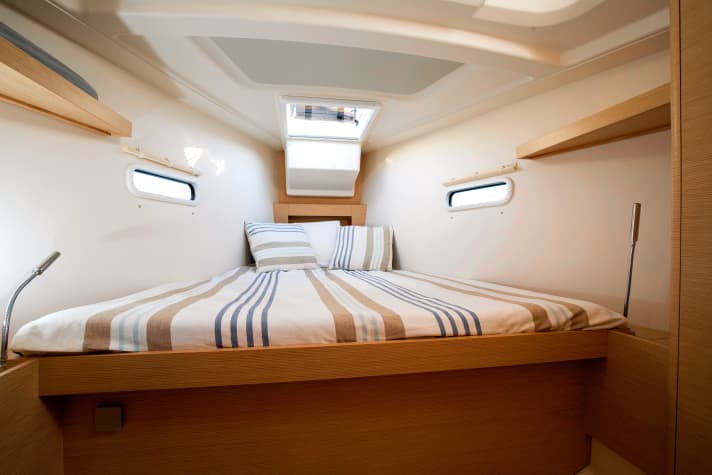
The standard aft cabin on the port side is trimmed for comfort and volume. There is no locker protruding into the headliner, which would impair the footwell and create a feeling of confinement. Windows in the hull and superstructure as well as one that can be opened towards the cockpit are pleasing. The cupboard space is well dimensioned, but the open storage compartment is too small and above all too shallow for use at sea. The forecastle locker sacrificed to the cabin is partially compensated for by two storage compartments in the cockpit floor, and there is a third in the cockpit to starboard. Nevertheless, in the three-cabin version, lines, fenders and other items can be stored in the three stowage compartments, but additional sails, cockpit cushions or folding bikes would have to sail in one of the compartments.
The Hanse 388 is pretty, if not perfect
In the test version, the Hanse 388 looks bright and friendly on the one hand and yet cosy and aft enough on the other, especially in comparison to the earlier version, which came with a white main bulkhead - purely a matter of taste.
The workmanship is pleasing, even if there are occasionally unsightly joints and transitions, which seem unavoidable in mass production. In any case, the installations are well done and important things such as seacocks, fuses, devices and connections are easily accessible and neatly documented. The latter can also be accessed electronically by the owner: the technical documents can be used online on mobile devices via the Hanse app.
As part of the cruising package, Hanseyachts also installs various sensors on board that can trigger various alarms on the owner's smartphone or allow certain monitoring of the battery voltage, for example. The service itself is free of charge for the first two years.
Measured values Hanse 388
Sailing performance, without drift and current
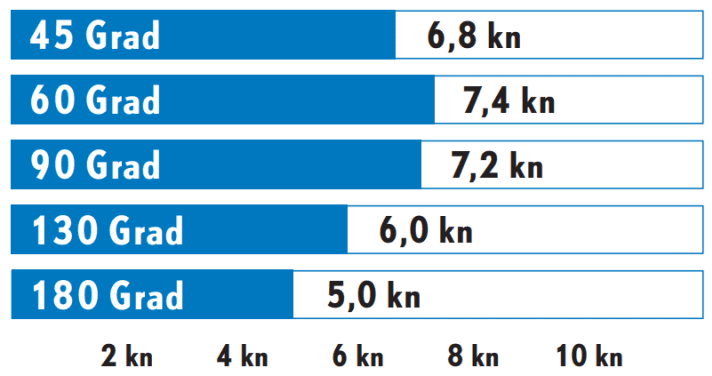
Wind speed: 11-13 kn (4 Bft), wave height: smooth water
Potential

With a self-tacking jib, the Hanse is somewhat under-rigged for light winds
1: Dimensionless number. Calculation: 2√S/3√V. The higher the value, the more sail area (S) the ship has in relation to the displacement (V)
Berth dimensions
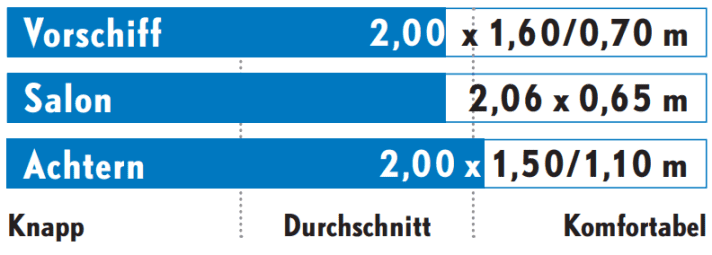
Standing height

Sound pressure

Measured at cruising speed (80 % of maximum speed):6.0 kn, 2,400 min -1
YACHT review Hanse 388
Ease of use, good performance and superior living comfort speak in favour of the Hanse 388, which is a good modern boat with a competitive price and a high degree of customisability in all important respects
Design and concept
- + Proven design
- + Good choice of options
- - No variable draught possible
Sailing performance and trim
- + Good speed that is easy to call up
- + Pleasant steering behaviour
- + Deck layout suitable for small crews
Living and finishing quality
- + Harmonious room distribution and appearance
- - Too small shelves in the cabins
- - Little storage space in the back box
Equipment and technology
- + Good ventilation in cabins
- + Clean installations
- - Weak cross ventilation in the lounge
Technical data Hanse 388
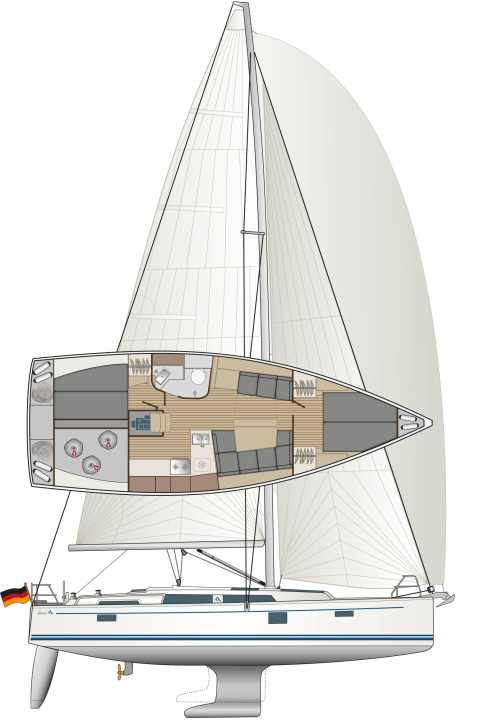
- Designer:Judel/Vrolijk & Co
- CE design category: A
- Torso length: 10,99 m
- Total length:11,40 m
- Waterline length: 10,40 m
- Width:3,90 m
- Draught/alternative:2,06/1,62 m
- Mast height above waterline: 17,60 m
- Theoretical torso speed: 7.84 kn
- Weight: 8,3 t
- Ballast/proportion: 2,4 t/29 %
- Mainsail: 43,5 m²
- Self-tacking jib: 28,5 m²
- Machine: 20 kW/27 hp
- Fuel tank:160 l
- Fresh water tank: 295 l
- Holding tank: 35 l
Hull and deck construction
Hand lay-up method. GRP sandwich with balsa wood core. Isophthalic acid gelcoat, first laminate layer with vinyl ester resin. Underwater hull full laminate. Bulkheads with angle laminate. Hull-deck joint partially laminated
Base price ex shipyard
208,131 euros, gross incl. 19 % VAT (as at June 2023)
This test appeared in YACHT issue 23/2019 and was revised by the editorial team in June 2023.

